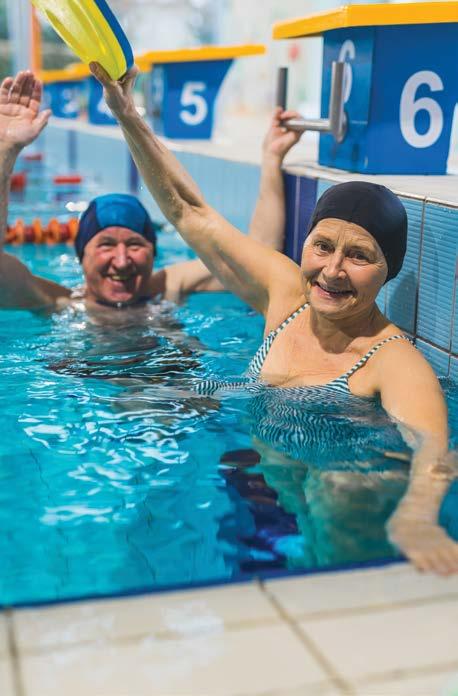
3 minute read
Exercising after joint replacement ..............Judith A. Rucki
Exercising after joint replacement
Safe fitness for the “bionic” you
BY JUDITH RUCKI
Especially among older people, joint replacement is often what puts an end to years of painkillers, steroid shots, and difficulty walking or sleeping. But once the knees and hips have been replaced, getting back to pre-problem levels of activity can be challenging.

There are no set timetables. Some patients take the better part of a year to fully recover from knee or hip surgery, while others take just a few months. “If you were very active, you will do better,” says Quanteria Williams-Porche, a physical therapist with Split Second Fitness, who has worked for more than a decade with people recovering from hip and knee replacements. Of course, the more active you were, the more eager you’ll be to get moving. “Walking is your best friend, especially after hip surgery,” says Williams-Porche. But check with your medical team about how much and how soon. Too much walking can stress implants prior to the ingrowth process.
Patients are often concerned about never being able to resume certain activities, says WilliamsPorche, but the good news is, “People usually have no restrictions afterward.”
Most patients won’t be prohibited certain activities, but low-impact activities are often recommended to longer preserve the integrity of the joint. Williams-Porche advises consulting with your surgeon as you “gradually work your way back.”
The pros at orthoInfo.com suggest staying active with the caveat that you do not do too much too soon. Once you have your doctor’s go-ahead, “you can return to many of the sports activities you enjoyed before your hip replacement.”
Where there is caution, it’s around high-impact activities such as singles tennis, jogging, racquetball, basketball, and skiing, which may put too much stress




on hip joints. Consider lower impact cardio options like golfing, bicycling, doubles tennis, and especially joint friendly swimming. Recommendations for knee replacements are similar. Lower impact fitness activities as those described above “will help increase the longevity of your knee and are preferable over high-impact activities such as jumping, jogging, and skiing,” according to orthoinfo. Contact sports, like football and soccer, plus sports that require jerking, twisting, or pulling should be avoided, as well as overly repetitive motions like running, heavy weightlifting, and jumping, which can damage an implant over time.
At the gym, talk to a trainer about elliptical and stair machines or stationary bikes. Another option is low-resistance circuit training. This involves moving from one machine to the next with little or no resting time in-between.
Yoga practitioners should consult their doctors before resuming higher-intensity yoga and pass along any restrictions to the instructor who can help with appropriate modifications. Or they may ease back into practice with gentler, restorative routines or even chair yoga. “Chair yoga is effective for the right person,” says Silver Sneakers yoga instructor Olivia Ebsary. “This is typically a population over age seventy or senior citizens rehabbing from something.” Pilates instructor Annemarie Gorman advises clients who had joint replacement surgery to ease back into a routine for at least six weeks. She also advises that resuming pre-surgery levels of everyday activities—excluding intense exercise—is a goal: “Don’t be hesitant to do things. Have confidence that your surgery was a success. You will be able to return to regular activities. That’s the whole reason why we have surgery.” FY

Judith A. Rucki is a public relations consultant and freelance writer.








